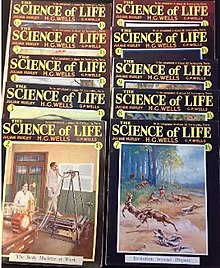The Science of Life

Title Page of 1934 Edition
|
|
| Author | H. G. Wells, Julian S. Huxley, and G. P. Wells |
|---|---|
| Country | UK |
| Language | English |
| Genre | Non-Fiction |
| Publisher | Cassels (England); Nelson Doubleday (US) |
|
Publication date
|
1929 |
| Media type | Print (hardback) |
| Pages | 1514 (Cassell 1938 edition: 1575 pages, 32 plates, 263 figures) |
The Science of Life is a book written by H. G. Wells, Julian Huxley and G. P. Wells, published in three volumes by The Waverley Publishing Company Ltd in 1929–30, giving a popular account of all major aspects of biology as known in the 1920s. It has been called "the first modern textbook of biology" and "the best popular introduction to the biological sciences." Wells's most recent biographer notes that The Science of Life "is not quite as dated as one might suppose."
In undertaking The Science of Life, H. G. Wells, who had published The Outline of History a decade earlier, selling over two million copies, desired the same sort of treatment for biology. He thought of his readership as "the intelligent lower middle classes . . . [not] idiots, half-wits . . . greenhorns, religious fanatics . . . smart women or men who know all that there is to be known."
Julian Huxley, the grandson of T. H. Huxley under whom Wells had studied biology, and his son "Gip," a zoologist, divided the initial writing between them; H.G. Wells revised, dealt (with the help of his literary agent, A.P. Watt) with publishers, and acted as a strict taskmaster, often obliging his collaborators to sit down and work together and keeping them on a tight schedule. (H.G. Wells had begun the book during his wife's final illness and is said to have used work on the book as a way to keep his mind off his loss.)
The text as published is presented as the common work of a "triplex author." H.G. Wells took 40% of the royalties; the remainder was split between Huxley and Wells's son. In his will, H.G. Wells left his rights in the book to G.P. Wells.
In 1927, Huxley gave up his chair of Zoology at King's College, London to concentrate on the work. Thanks to the success of the book, Huxley was able to give up teaching and devote himself to administration and experimental science.
The book was originally serialised in 31 fortnightly parts, published in 3 volumes in 1929–30 and in a single volume in 1931. The volume includes more than 300 illustrations. It was a great success, though the stock market crash and subsequent depression held back sales, in part because of declining memberships in book clubs.
It has been said of Book Four (The How and Why of Development and Evolution) that it "offers perhaps the clearest, most readable, succinct and informative popular account of the subject ever penned. It was here that [Huxley] first expounded his own version of what later developed into the evolutionary synthesis".
...
Wikipedia
